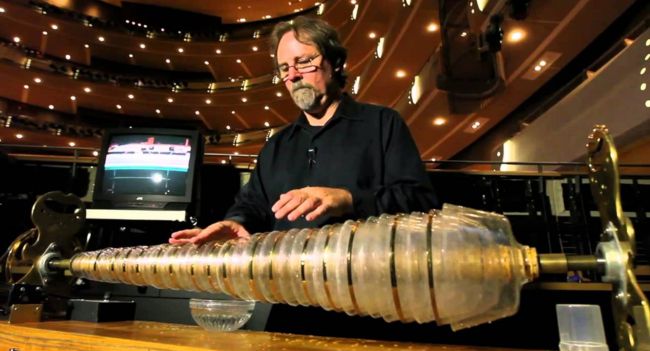We’re all familiar with keyboard instruments. Many of us have also heard (or indeed made) music of a kind with the rims of wine glasses. But to unite the two required the truly American combination of genius, wherewithal, and penchant for folly found in one historical figure above all: Benjamin Franklin. As we’ve previously noted here on Open Culture, the musically inclined Franklin invented an instrument called the glass armonica (alternatively “glass harmonica”)—or rather, he re-invented it, having seen and heard an early example played in London. Essentially a series of differently sized bowls arranged from large to small, all rotating on a shaft, the glass armonica allows its player to make polyphonic music of a downright celestial nature.
The playing, however, is easier written about than done. You can see that for yourself in the video above, in which guitarist Rob Scallon visits musician-preservationist Dennis James. Not only does James play a glass armonica, he plays a glass armonica he built himself—and has presumably rebuilt a few times as well, given its scarcely believable fragility.
Transportation presents its challenges, but so does the act of playing, which requires a routine of hand-washing (and subsequent re-wetting with distilled water only) that even the coronavirus hasn’t gotten most of us used to. But even in the hands of a first-timer like Scallon, who makes sure to take his turn at the keyboard of bowls, the glass armonica sounds like no other instrument that even most of us in the 21st century have heard. In the hands of one of its few living virtuosos, of course, the glass armonica is something entirely different.
“If this piece didn’t exist,” says James, holding a piece of sheet music, “I wouldn’t be sitting here.” He refers to Adagio & Rondo for glass armonica in C minor (KV 617), composed by none other than Wolfgang Amadeus Mozart. “In 1791, the last year of his life, Mozart wrote a piece for the German armonica player, Marianne Kirchgässner,” writes Timoty Judd at The Listeners’ Club. Like every glass armonica piece, according to James, one ends it by dropping suddenly into complete silence: “It’s the only instrument, up until that point, that could die away to absolutely nothing.” Alas, writes James, not long after the debut of Mozart’s composition, rumors circulated that “the strange, crystalline tones of Benjamin Franklin’s new instrument were a threat to public health.” It is a shame, though, that it seems today, but it does suit the multitalented Franklin’s ancillary reputation as an inveterate troublemaker.
